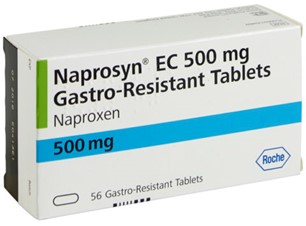Anti-inflammatory and Immunosuppressive Drugs > Pharmacology
Exam Review
Adverse effects of NSAIDs
Total Questions : 3
Showing 3 questions, Sign in for moreA nurse is teaching a client who has peptic ulcer disease and is prescribed misoprostol (Cytotec), a synthetic prostaglandin. What should the nurse include in the teaching?
Explanation
Misoprostol is a synthetic prostaglandin that works by "replacing" prostaglandins whose production is blocked by aspirin or NSAIDs¹. Prostaglandins are hormone-like substances that help protect the stomach lining from damage caused by acid and pepsin². Misoprostol produces a dose-related inhibition of gastric acid and pepsin secretion and enhances mucosal resistance to injury¹.
The other options are incorrect because:
- A. The drug does not have anti-inflammatory and analgesic effects by blocking the production of prostaglandins. On the contrary, it stimulates the production of prostaglandins to protect the stomach lining. Blocking the production of prostaglandins would increase the risk of ulcers.
- B. The drug does not have antipyretic and antiplatelet effects by blocking the production of prostaglandins. Antipyretic means reducing fever, and antiplatelet means preventing blood clots. Misoprostol does not have these effects, and blocking the production of prostaglandins would not cause them either.
- D. The drug does not have renal protective effects by stimulating the production of prostaglandins. Renal means related to the kidneys, and misoprostol does not affect the kidneys. Stimulating the production of prostaglandins would not protect the kidneys either.
A nurse is administering naproxen (Naprosyn), a nonselective COX inhibitor, to a client who has bursitis. What are some of the contraindications for this drug?
Explanation
Naproxen is a nonselective COX inhibitor, which means it blocks the production of prostaglandins, which are involved in inflammation, pain, fever, and blood clotting. Naproxen can cause serious side effects such as cardiovascular thrombotic events, gastrointestinal bleeding and ulceration, renal toxicity, and hypersensitivity reactions¹²³.
The other options are incorrect because:
- B. Asthma, hypertension, heart failure, diabetes, dehydration, alcoholism, smoking, advanced age, and concurrent use of anticoagulants, glucocorticoids, or other NSAIDs are not contraindications for naproxen, but they are cautions or risk factors that may increase the likelihood of adverse effects or require dose adjustment or monitoring¹²³.
- C. History of cardiovascular thrombotic events, such as myocardial infarction or stroke, severe allergic reactions to NSAIDs or aspirin, such as anaphylaxis or angioedema, and coronary artery bypass graft surgery are not specific contraindications for naproxen, but they are warnings that apply to all NSAIDs due to their potential to increase the risk of these serious events¹²³.
- D. None of the above is incorrect because option A contains some valid contraindications for naproxen.

A nurse is evaluating a client who has fever and is receiving ibuprofen (Motrin), a nonselective COX inhibitor. What are some of the outcomes that indicate the effectiveness of the therapy?
Explanation
Ibuprofen is a nonselective COX inhibitor, which means it blocks the production of prostaglandins, which are involved in inflammation, pain, fever, and blood clotting. Ibuprofen has antipyretic (fever-reducing) effects by inhibiting the synthesis of prostaglandins in the hypothalamus, the part of the brain that regulates body temperature . Ibuprofen can lower fever by 1 to 2°C within 2 to 4 hours of administration . The normal body temperature range is 36.5 to 37.5°C (97.7 to 99.5°F).
The other options are incorrect because:
B. Decreased inflammation, pain, and swelling are not outcomes that indicate the effectiveness of ibuprofen therapy for fever. These are outcomes that indicate the effectiveness of ibuprofen therapy for inflammation and pain, which are other indications for ibuprofen. Ibuprofen has anti-inflammatory and analgesic effects by blocking the production of prostaglandins that mediate inflammation and pain . However, these effects are not relevant for fever management.
C. Decreased risk of gastrointestinal bleeding and ulceration are not outcomes that indicate the effectiveness of ibuprofen therapy for fever. These are outcomes that indicate the prevention or reduction of adverse effects of ibuprofen therapy. Ibuprofen has gastrointestinal effects such as nausea, vomiting, ulceration, bleeding, and perforation by blocking the production of prostaglandins that protect the stomach lining from acid and pepsin . These effects are more likely to occur in patients with a history of peptic ulcer disease or gastrointestinal bleeding or in patients who take high doses or long-term use of ibuprofen. The nurse should monitor the client for signs and symptoms of gastrointestinal bleeding and ulceration such as abdominal pain, black or bloody stools, hematemesis (vomiting blood), melena (dark tarry stools), anemia (low red blood cell count), or hypotension (low blood pressure). The nurse should also advise the client to take ibuprofen with food or milk to reduce gastric irritation and to avoid alcohol or other NSAIDs that may increase the risk of gastrointestinal bleeding and ulceration.
D. Decreased risk of hepatotoxicity and liver impairment are not outcomes that indicate the effectiveness of ibuprofen therapy for fever. These are outcomes that indicate the prevention or reduction of adverse effects of ibuprofen therapy. Ibuprofen has hepatic effects such as elevated liver enzymes, jaundice (yellowing of skin or eyes), hepatitis (inflammation of liver), and liver failure by affecting hepatic function and metabolism . These effects are rare but serious and may occur in patients with hepatic impairment or risk factors for hepatic toxicity such as alcoholism or concurrent use of other hepatotoxic drugs. The nurse should monitor the client's liver function tests and report any abnormal results or signs and symptoms of liver injury such as nausea, vomiting, anorexia (loss of appetite), fatigue
Sign Up or Login to view all the 3 Questions on this Exam
Join over 100,000+ nursing students using Nursingprepexams’s science-backend flashcards, practice tests and expert solutions to improve their grades and reach their goals.
Sign Up Now

